曼昆经济学原理Chapter 3
曼昆经济学原理第七版第三章
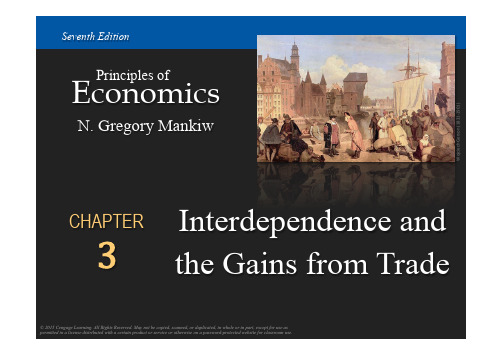
© 2015 Cengage Learning. All Rights Reserved. May not be copied, scanned, or duplicated, in whole or in part, except for use as permitted in a license distributed with a certain product or service or otherwise on a password-protected website for classroom use.
9
© 2015 Cengage Learning. All Rights Reserved. May not be copied, scanned, or duplicated, in whole or in part, except for use as permitted in a license distributed with a certain product or service or otherwise on a password-protected website for classroom use.
Wheat (tons) 5,000 4,000 3,000 2,000 1,000 0
The U.S. Without Trade
Suppose the U.S. uses half its labor to produce each of the two goods. Then it will produce and consume 250 computers and 2500 tons of wheat.
© 2015 Cengage Learning. All Rights Reserved. May not be copied, scanned, or duplicated, in whole or in part, except for use as permitted in a license distributed with a certain product or service or otherwise on a password-protected website for classroom use.
曼昆《经济学原理(微观经济学分册)》(第6版)课后习题详解(第3章 相互依存性与贸易的好处)
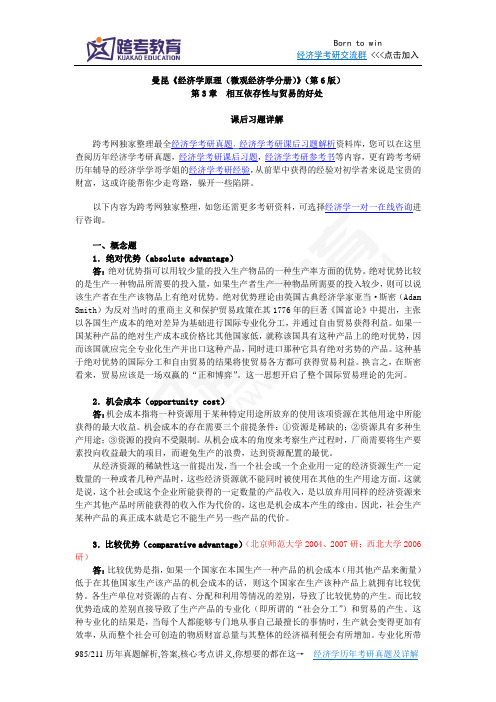
曼昆《经济学原理(微观经济学分册)》(第6版)第3章相互依存性与贸易的好处课后习题详解跨考网独家整理最全经济学考研真题,经济学考研课后习题解析资料库,您可以在这里查阅历年经济学考研真题,经济学考研课后习题,经济学考研参考书等内容,更有跨考考研历年辅导的经济学学哥学姐的经济学考研经验,从前辈中获得的经验对初学者来说是宝贵的财富,这或许能帮你少走弯路,躲开一些陷阱。
以下内容为跨考网独家整理,如您还需更多考研资料,可选择经济学一对一在线咨询进行咨询。
一、概念题1.绝对优势(absolute advantage)答:绝对优势指可以用较少量的投入生产物品的一种生产率方面的优势。
绝对优势比较的是生产一种物品所需要的投入量,如果生产者生产一种物品所需要的投入较少,则可以说该生产者在生产该物品上有绝对优势。
绝对优势理论由英国古典经济学家亚当·斯密(Adam Smith)为反对当时的重商主义和保护贸易政策在其1776年的巨著《国富论》中提出,主张以各国生产成本的绝对差异为基础进行国际专业化分工,并通过自由贸易获得利益。
如果一国某种产品的绝对生产成本或价格比其他国家低,就称该国具有这种产品上的绝对优势,因而该国就应完全专业化生产并出口这种产品,同时进口那种它具有绝对劣势的产品。
这种基于绝对优势的国际分工和自由贸易的结果将使贸易各方都可获得贸易利益。
换言之,在斯密看来,贸易应该是一场双赢的“正和博弈”。
这一思想开启了整个国际贸易理论的先河。
2.机会成本(opportunity cost)答:机会成本指将一种资源用于某种特定用途所放弃的使用该项资源在其他用途中所能获得的最大收益。
机会成本的存在需要三个前提条件:①资源是稀缺的;②资源具有多种生产用途;③资源的投向不受限制。
从机会成本的角度来考察生产过程时,厂商需要将生产要素投向收益最大的项目,而避免生产的浪费,达到资源配置的最优。
从经济资源的稀缺性这一前提出发,当一个社会或一个企业用一定的经济资源生产一定数量的一种或者几种产品时,这些经济资源就不能同时被使用在其他的生产用途方面。
曼昆微观经济学 第三章
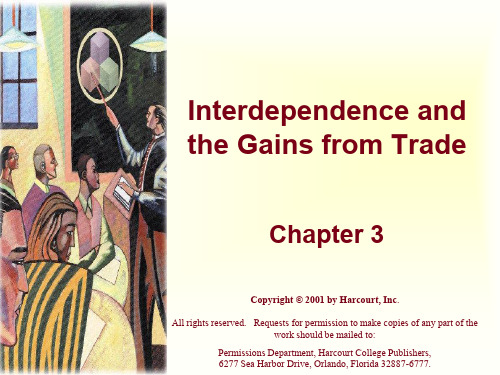
Production Possibilities Frontiers
Meat (ounces)
8 4
(a) The Farmer’s Production Possibilities Frontier
If there is no trade,the farmer chooses this production and consumption
We can specialize and trade with others, leading to economic
interdependence.
Harcourt, Inc. items and derived items copyright © 2001 by Harcourt, Inc.
manufactured in a half-dozen different countries. …and you haven’t been up for more than two hours yet!
Harcourt, Inc. items and derived items copyright © 2001 by Harcourt, Inc.
24 potatoes
Harcourt, Inc. items and derived items copyright © 2001 by Harcourt, Inc.
The Gains from Trade:
A Summary
Farmer Rancher
The Outcome With Trade:
Copyright©2003 Southwestern/Thomson Learning
How Trade Expands the Set of Consumption Opportunities
微观经济学 曼昆 第三章
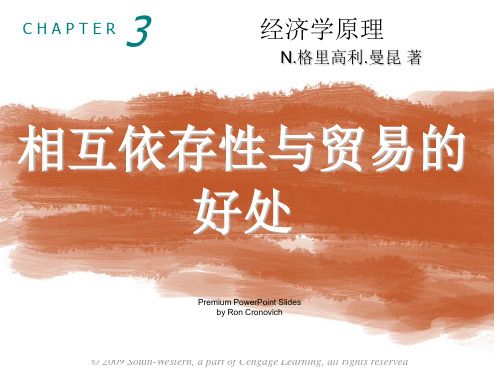
27
未回答的问题
我们关于每个国家生产,贸易,消费的物品数量 和国家之间小麦和电脑贸易的价格做了许多假设 在现实世界中,这些数量和价格是被两个国家的 消费者的偏好,生产技术以及资源禀赋决定的 我们将在下章开始这些的学习 因为现在我们的目标只是说明贸易怎样使每个人 的状况变得更好
相互依存性与贸易的好处
相互依存性与贸易的好处
22
机会成本与比较优势
比较优势: 比较优势:一个生产者以低于另一个生产者的机 会成本生产一种物品的能力 哪个国家在生产电脑上具有比较优势 为回答这个问题,必须知道各个国家生产1台电脑 的机会成本
相互依存性与贸易的好处
23
机会成本与比较优势
生产1台电脑的机会成本: 美国是10吨小麦,因为美国生产1台电脑需要 100个劳动小时,而100个劳动小时可以生产10 吨小麦 日本是5吨小麦,因为日本生产1台电脑需要 125个小时,而125个小时能够生产5吨小麦 因此,日本在生产电脑上有比较优势 总结:绝对优势并不意味着比较优势!
相互依存性与贸易的好处
4
美国的生产可能性
美国每个月有50,000个小时的劳动能用在生产 上
生产1台电脑需要100个小时的劳动
生产1吨小麦需要10个小时的劳动
相互依存性与贸易的好处
5
美国的生产可能性曲线
小麦 (吨) 吨 5,000 4,000 3,000 2,000 1,000 0 电脑( 电脑(台) 100 200 300 400 500
1,000
0
电脑( 电脑(台) 100 200 300
10
相互依存性与贸易的好处
存在贸易与不存在贸易条件下的消费
不存在贸易: 美国的消费者总共消费250台电脑和2500吨小 麦 日本的消费者总共消费120台电脑和600吨小麦 我们比较存在贸易与不存在贸易条件下的消费 首先,我们需要知道两个国家电脑和小麦的产量 和贸易量
经济学原理曼昆课后答案chapter3
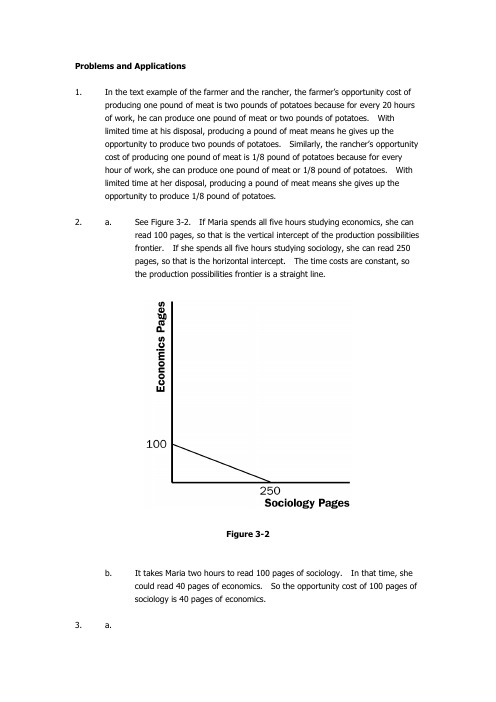
Problems and Applications1.In the text example of the farmer and the rancher, the farmer’s opportunity cost ofproducing one pound of meat is two pounds of potatoes because for every 20 hours of work, he can produce one pound of meat or two pounds of potatoes. Withlimited time at his disposal, producing a pound of meat means he gives up theopportunity to produce two pounds of potatoes. Similarly, the rancher’s opportunity cost of producing one pound of meat is 1/8 pound of potatoes because for everyhour of work, she can produce one pound of meat or 1/8 pound of potatoes. Withlimited time at her disposal, producing a pound of meat means she gives up theopportunity to produce 1/8 pound of potatoes.2. a.See Figure 3-2. If Maria spends all five hours studying economics, she canread 100 pages, so that is the vertical intercept of the production possibilitiesfrontier. If she spends all five hours studying sociology, she can read 250pages, so that is the horizontal intercept. The time costs are constant, sothe production possibilities frontier is a straight line.Figure 3-2b.It takes Maria two hours to read 100 pages of sociology. In that time, shecould read 40 pages of economics. So the opportunity cost of 100 pages ofsociology is 40 pages of economics.3. a.Workers needed to make:One Car One Ton of Grain U.S.1/41/10Japan1/41/5b.See Figure 3-3. With 100 million workers and four cars per worker, if eithereconomy were devoted completely to cars, it could make 400 million cars.Since a U.S. worker can produce 10 tons of grain, if the U.S. produced onlygrain it would produce 1,000 million tons. Since a Japanese worker canproduce 5 tons of grain, if Japan produced only grain it would produce 500million tons. These are the intercepts of the production possibilities frontiers shown in the figure. Note that since the tradeoff between cars and grain isconstant, the production possibilities frontier is a straight line.Figure 3-3c.Since a U.S. worker produces either 4 cars or 10 tons of grain, theopportunity cost of 1 car is 2½ tons of grain, which is 10 divided by 4.Since a Japanese worker produces either 4 cars or 5 tons of grain, theopportunity cost of 1 car is1 1/4 tons of grain, which is 5 divided by 4. Similarly, the U.S. opportunitycost of 1 ton of grain is 2/5 cars (4 divided by 10) and the Japaneseopportunity cost of 1 ton of grain is 4/5 cars (4 divided by 5). This gives the following table:Opportunity Cost of:1 Car (in terms of tons ofgrain given up)1 Ton of Grain (in termsof cars given up)U.S. 2 1/22/5Japan 1 1/44/5d.Neither country has an absolute advantage in producing cars, since they’reequally productive (the same output per worker); the U.S. has an absoluteadvantage in producing grain, since it’s more productive (greater output perworker).e.Japan has a comparative advantage in producing cars, since it has a loweropportunity cost in terms of grain given up. The U.S. has a comparativeadvantage in producing grain, since it has a lower opportunity cost in termsof cars given up.f.With half the workers in each country producing each of the goods, the U.S.would produce 200 million cars (that’s 50 million workers times 4 cars each)and 500 million tons of grain (50 million workers times 10 tons each).Japan would produce 200 million cars (50 million workers times 4 cars each)and 250 million tons of grain (50 million workers times 5 tons each).g.From any situation with no trade, in which each country is producing somecars and some grain, suppose the U.S. changed 1 worker from producingcars to producing grain. That worker would produce 4 fewer cars and 10additional tons of grain. Then suppose the U.S. offers to trade 7 tons ofgrain to Japan for 4 cars. The U.S. will do this because it values 4 cars at 10tons of grain, so it will be better off if the trade goes through. SupposeJapan changes 1 worker from producing grain to producing cars. Thatworker would produce 4 more cars and 5 fewer tons of grain. Japan willtake the trade because it values 4 cars at 5 tons of grain, so it will be betteroff. With the trade and the change of 1 worker in both the U.S. and Japan,each country gets the same amount of cars as before and both get additionaltons of grain (3 for the U.S. and 2 for Japan). Thus by trading and changingtheir production, both countries are better off.4. a.Pat’s opportunity cost of making a pizza is 1/2 gallon of root beer, since shecould brew 1/2 gallon in the time (2 hours) it takes her to make a pizza. Pathas an absolute advantage in making pizza since she can make one in twohours, while it takes Kris four hours. Kris’s opportunity cost of making apizza is 2/3 gallons of root beer, since she could brew 2/3 of a gallon in thetime (4 hours) it takes her to make a pizza. Since Pat’s opportunity cost ofmaking pizza is less than Kris’s, Pat has a comparative advantage in makingpizza.b.Since Pat has a comparative advantage in making pizza, she will make pizzaand exchange it for root beer that Kris makes.c.The highest price of pizza in terms of root beer that will make bothroommates better off is 2/3 gallons of root beer. If the price were higherthan that, then Kris would prefer making her own pizza (at an opportunitycost of 2/3 gallons of root beer) rather than trading for pizza that Pat makes.The lowest price of pizza in terms of root beer that will make bothroommates better off is 1/2 gallon of root beer. If the price were lower thanthat, then Pat would prefer making her own root beer (she can make 1/2gallon of root beer instead of making a pizza) rather than trading for rootbeer that Kris makes.5. a.Since a Canadian worker can make either two cars a year or 30 bushels ofwheat, the opportunity cost of a car is 15 bushels of wheat. Similarly, theopportunity cost of a bushel of wheat is 1/15 of a car. The opportunitycosts are the reciprocals of each other.b.See Figure 3-4. If all 10 million workers produce two cars each, theyproduce a total of 20 million cars, which is the vertical intercept of theproduction possibilities frontier. If all 10 million workers produce 30 bushelsof wheat each, they produce a total of 300 million bushels, which is thehorizontal intercept of the production possibilities frontier. Since thetradeoff between cars and wheat is always the same, the productionpossibilities frontier is a straight line.If Canada chooses to consume 10 million cars, it will need 5 million workersdevoted to car production. That leaves 5 million workers to produce wheat,who will produce a total of 150 million bushels (5 million workers times 30bushels per worker). This is shown as point A on Figure 3-4.c.If the United States buys 10 million cars from Canada and Canada continuesto consume 10 million cars, then Canada will need to produce a total of 20million cars. So Canada will be producing at the vertical intercept of theproduction possibilities frontier. But if Canada gets 20 bushels of wheat percar, it will be able to consume 200 million bushels of wheat, along with the10 million cars. This is shown as point B in the figure. Canada should acceptthe deal because it gets the same number of cars and 50 million morebushes of wheat.Figure 3-46.Though the professor could do both writing and data collection faster than thestudent (that is, he has an absolute advantage in both), his time is limited. If theprofessor’s comparative advantage is in writing, it makes sense for him to pay astudent to collect the data, since that’s the student’s comparative advantage.7. a.English workers have an absolute advantage over Scottish workers inproducing scones, since English workers produce more scones per hour (50vs. 40). Scottish workers have an absolute advantage over English workersin producing sweaters, since Scottish workers produce more sweaters perhour (2 vs. 1). Comparative advantage runs the same way. Englishworkers, who have an opportunity cost of 1/50 sweaters per scone (1sweater per hour divided by 50 scones per hour), have a comparativeadvantage in scone production over Scottish workers, who have anopportunity cost of 1/20 sweater per scone (2 sweaters per hour divided by40 scones per hour). Scottish workers, who have an opportunity cost of 20scones per sweater (40 scones per hour divided by 2 sweaters per hour),have a comparative advantage in sweater production over English workers,who have an opportunity cost of 50 scones per sweater (50 scones per hourdivided by 1 sweater per hour).b.If England and Scotland decide to trade, Scotland will produce sweaters andtrade them for scones produced in England. A trade with a price between20 and 50 scones per sweater will benefit both countries, as they’ll be gettingthe traded good at a lower price than their opportunity cost of producing thegood in their own country.c.Even if a Scottish worker produced just one sweater per hour, the countrieswould still gain from trade, because Scotland would still have a comparativeadvantage in producing sweaters. Its opportunity cost for sweaters wouldbe higher than before (40 scones per sweater, instead of 20 scones persweater before). But there are still gains from trade since England has ahigher opportunity cost (50 scones per sweater).8. a.Technological advance lowers the opportunity cost of producing meat for thefarmer. The opportunity cost of producing a point of meat was 2 pounds ofpotatoes; it’s now 1/5 pounds of potatoes. Thus the farmer’s opportunitycost of producing potatoes is now 5 pounds of meat. Since the rancher’sopportunity cost of producing potatoes is 8 pounds of meat, the farmer stillhas a comparative advantage in producing potatoes and the rancher still hasa comparative advantage in producing meat.b.Now the farmer won’t be willing to trade a pound of potatoes for 3 pounds ofmeat because if he produced one less pound of potatoes, he could produce 5more pounds of meat. So the trade would be bad for the farmer, as hewould then be consuming inside his production possibilities frontier.c.The farmer and rancher would now be willing to trade one pound of potatoesfor an amount between 5 and 8 pounds of meat, with the potatoes beingproduced by the farmer and the meat being produced by the rancher.9. a.With no trade, one pair of white socks trades for one pair of red socks inBoston, since productivity is the same for the two types of socks. The pricein Chicago is 2 pairs of red socks per pair of white socks.b.Boston has an absolute advantage in the production of both types of socks,since a worker in Boston produces more (3 pairs of socks per hour) than aworker in Chicago (2 pairs of red socks per hour or 1 pair of white socks perhour).Chicago has a comparative advantage in producing red socks, since theopportunity cost of producing a pair of red socks in Chicago is 1/2 pair ofwhite socks, while the opportunity cost of producing a pair of red socks inBoston is 1 pair of white socks. Boston has a comparative advantage inproducing white socks, since the opportunity cost of producing a pair ofwhite socks in Boston is 1 pair of red socks, while the opportunity cost ofproducing a pair of white socks in Chicago is 2 pairs of red socks.c.If they trade socks, Boston will produce white socks for export, since it hasthe comparative advantage in white socks, while Chicago produces red socksfor export, which is Chicago’s comparative advantage.d.Trade can occur at any price between 1 and 2 pairs of red socks per pair ofwhite socks. At a price lower than 1 pair of red socks per pair of whitesocks, Boston will choose to produce its own red socks (at a cost of 1 pair ofred socks per pair of white socks) instead of buying them from Chicago. Ata price higher than 2 pairs of red socks per pair of white socks, Chicago willchoose to produce its own white socks (at a cost of 2 pairs of red socks perpair of white socks) instead of buying them from Boston.10. a.The cost of all goods is lower in Germany than in France in the sense that allgoods can be produced with fewer worker hours.b.The cost of any good for which France has a comparative advantage is lowerin France than in Germany. Though Germany produces all goods with lesslabor, that labor is more valuable. So the cost of production, in terms ofopportunity cost, will be lower in France for some goods.c.Trade between Germany and France will benefit both countries. For eachgood in which it has a comparative advantage, each country should producemore goods than it consumes, trading the rest to the other country. Totalconsumption will be higher in both countries as a result.11. a.True; two countries can achieve gains from trade even if one of the countrieshas an absolute advantage in the production of all goods. All that’snecessary is that each country have a comparative advantage in some good.b.False; it is not true that some people have a comparative advantage ineverything they do. In fact, no one can have a comparative advantage ineverything. Comparative advantage reflects the opportunity cost of onegood or activity in terms of another. If you have a comparative advantagein one thing, you must have a comparative disadvantage in the other thing.c.False; it is not true that if a trade is good for one person, it can’t be good forthe other one. Trades can and do benefit both sides especially tradesbased on comparative advantage. If both sides didn’t benefit, trades wouldnever occur.。
曼昆《经济学原理》3 interdependence--(汉魅HanMei—经济金融类汇总分享)

Copyright © 2004 South-Western
A PARABLE FOR THE MODERN ECONOMY
• Imagine . . .
Copyright © 2004 South-Western
• . . . and you haven’t been up for more than two hours yet!
Copyright © 2004 South-Western
Interdependence and the Gains from Trade
Interdependence and the Gains from Trade
3
Copyright © 2004 South-Western/Thomson Learning
• Consider your typical day:
• You wake up to an alarm clock made in Korea. • You pour yourself orange juice made from Florida oranges and coffee from beans grown in Brazil. • You put on some clothes made of cotton grown in Georgia and sewn in factories in Thailand. • You watch the morning news broadcast from New York on your TV made in Japan. • You drive to class in a car made of parts manufactured in a half-dozen different countries.
微观经济学原理(曼昆版课件)第三章
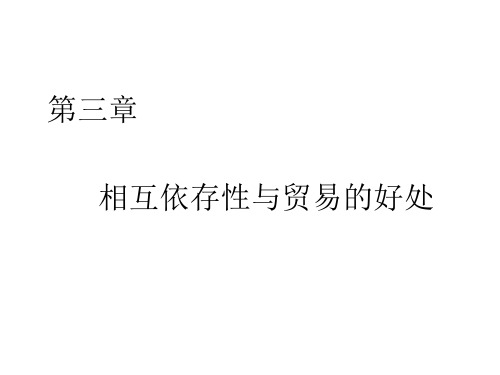
习题
• 下表描述了美国两个城市的生产可能性: 一个工人每小时生产的 红袜子量 一个工人每小时生产 的白袜子量
波士顿 芝加哥
3 2
3 1
1. 没有贸易时,波士顿一双白袜子的价格(用红袜子表示)?芝加 哥一双白袜子的价格? 2. 在每种颜色袜子的生产上,哪个城市有绝对优势?哪个城市有比 较优势? 3. 如果这两个城市互相贸易,两个城市将分别出口哪种颜色的袜子?
4. 可以进行交易的价格范围是多少?
白袜的价格范围:1双~2双红袜
红袜的价格范围:0.5双~1双白袜
4. 比较优势与贸易
• 专业化和贸易的好处不是基于绝对优势, 而是基于比较优势。当每个人专门生产自己有比较
优势的物品时,经济的总产量就增加了,而且,经济蛋糕 规模的这种扩大可以使每个人的状况更好。换句话说,只 要两个人有不同的机会成本,每个人都可以通过以低于自 己生产时的机会成本的价格得到一种物品,而从贸易中获 益。
5. 比较优势的应用
• 即问即答 鲁滨逊每小时可以摘10个椰子或捕一条鱼。 他的朋友礼拜五每小时可以摘30 个椰子或 捕2 条鱼。鲁滨逊捕一条鱼的机会成本是什 么?礼拜五的呢?谁在捕鱼方面有绝对优 势?谁在捕鱼方面有比较优势?
5. 比较优势的应用
• 即问即答 假设世界上打字最快的打字员恰好是外科 医生,他应该自己打字还是雇佣一个秘书? 并解释。
3. 机会成本和比较优势
对于牧牛人:生产1磅土豆的机会成本是?磅牛肉 对于农民:生产1磅土豆的机会成本是?磅牛肉
8 0注意:牛肉的机会成本是土豆的机会成本的倒数。由于1磅土豆要花 牧牛人的8磅牛肉,所以,1磅牛肉要花牧牛人1/8 磅的土豆. 同样, 由于1 磅土豆要花农民0.5 磅牛肉,所以,l 磅牛肉要花农民2磅土豆。
曼昆经济学原理试题Chapter 03a
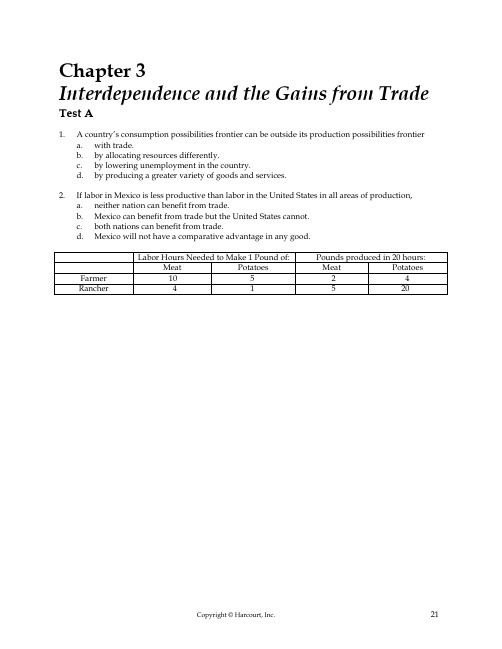
Chapter 3Interdependence and the Gains from Trade Test A1. A country’s consumption possibilities frontier can be outside its production possibilities frontiera. with trade.b. by allocating resources differently.c. by lowering unemployment in the country.d. by producing a greater variety of goods and services.2. If labor in Mexico is less productive than labor in the United States in all areas of production,a. neither nation can benefit from trade.b. Mexico can benefit from trade but the United States cannot.c. both nations can benefit from trade.d. Mexico will not have a comparative advantage in any good.22 Chapter 3/Interdependence and the Gains from Trade3. Refer to the table shown. For the Farmer, the opportunity cost of 1 pound of meat isa. 1/2 pound of potatoesb. 2 pounds of potatoes.c. 4 hours of labor.d. 8 hours of labor.4. Refer to the table shown. For the Rancher, the opportunity cost of 1 pound of meat isa. 1 hour of labor.b. 5 hours of labor.c. 4 pounds of potatoes.d. 1/4 pound of potatoes.5. Refer to the table shown. For the Farmer, the opportunity cost of 1 pound of potatoes isa. 1/2 pound of meat.b. 2 pounds of meat.c. 4 hours of labor.d. 8 hours of labor.6. Refer to the table shown. For the Rancher, the opportunity cost of 1 pound of potatoes isa. 4 hours of labor.b. 2 hours of labor.c. 4 pounds of meat.d. 1/4 pound of meat.7. Refer to the table shown. The Farmer has an absolute advantage in ______ and the Rancher has anabsolute advantage in ______.a. meat, meatb. meat, potatoesc. potatoes, meatd. neither good, both goods8. Refer to the table shown. The Rancher has a comparative advantage in ______ and the Farmer has acomparative advantage in ______.a. meat, potatoesb. both goods, neither goodc. potatoes, meatd. neither good, both goods9. Refer to the table shown. The Farmer and Rancher both could benefit by the Farmer specializing in______ and the Rancher specializing in ______.a. potatoes, meatb. meat, potatoesc. neither good, meatd. They cannot benefit by specialization and trade.Chapter 3/Interdependence and the Gains from Trade 23 These figures illustrate the production possibilities available to Tom and Nicole with 40 hours of labor.10. Refer to the graphs shown. The opportunity cost of 1 video for Tom isa. 1/2 book.b. 1 book.c. 2 books.d. 4 books.11. Refer to the graphs shown. The opportunity cost of 1 video for Nicole isa. 1/40 book.b. 1/8 book.c. 8 books.d. 40 books.RANDOM: N12. Refer to the graphs shown. The opportunity cost of 1 book for Nicole isa. 1/40 video.b. 1/8 video.c. 5 videos.d. 8 videos.TYPE: M KEY1: G SECTION: 2 OBJECTIVE: 3 GRAPH FORMAT: M QUESTION INSTRUCTION: 4 RANDOM: N13. Refer to the graphs shown. The opportunity cost of 1 book for Tom isa. 1/4 video.b. 1/2 video.c. 2 videos.d. 4 videos.TYPE: M KEY1: G SECTION: 2 OBJECTIVE: 3 GRAPH FORMAT: M QUESTION INSTRUCTION: 4 RANDOM: N24 Chapter 3/Interdependence and the Gains from Trade14. Refer to the graphs shown. Nicole has an absolute advantage in ______ and Tom has an absoluteadvantage in ______.a. books, videosb. videos, booksc. both goods, neither goodd. neither good, both goodsTYPE: M KEY1: G SECTION: 2 OBJECTIVE: 3 GRAPH FORMAT: M QUESTION INSTRUCTION: 4 RANDOM: N15. Refer to the graphs shown. Nicole has a comparative advantage in ______ and Tom has acomparative advantage in ______.a. books, videosb. both goods, neither goodc. videos, booksd. neither good, booksTYPE: M KEY1: G SECTION: 2 OBJECTIVE: 3 GRAPH FORMAT: M QUESTION INSTRUCTION: 4 RANDOM: N16. Refer to the graphs shown. Nicole should specialize in ______ and Tom should specialize in ______.a. videos, booksb. books, videosc. both goods, videosd. books, neither goodTYPE: M KEY1: G SECTION: 2 OBJECTIVE: 3 GRAPH FORMAT: M QUESTION INSTRUCTION: 4 RANDOM: N17. Refer to the graphs shown. If Tom and Nicole both specialize in the good in which they have acomparative advantage, total production of books will be ______ and total production of videos will be ______.a. 42, 9b. 40, 4c. 4, 40d. 9, 42TYPE: M KEY1: G SECTION: 2 OBJECTIVE: 3 GRAPH FORMAT: M QUESTION INSTRUCTION: 4 RANDOM: N18. Comparative advantage is based ona. capital costs.b. labor costs.c. dollar price.d. opportunity costs.TYPE: M KEY1: D SECTION: 2 OBJECTIVE: 3 RANDOM: Y19. Absolute advantage is found bya. comparing opportunity costs.b. calculating the dollar cost of production.c. first determining which country has a comparative advantage.d. comparing the productivity of one nation to that of another.TYPE: MKEY1: D SECTION: 2 OBJECTIVE: 3 RANDOM: YChapter 3/Interdependence and the Gains from Trade 2520. The principle of comparative advantage was developed bya. Adam Smith.b. Harry Truman.c. David Ricardo.d. John Maynard Keynes.TYPE: M KEY1: D SECTION: 3 OBJECTIVE: 4 RANDOM: Y21. Economists generally supporta. government management of trade.b. free international trade.c. trade restrictions.d. export subsidies.TYPE: M KEY1: D SECTION: 3 OBJECTIVE: 4 RANDOM: Y22. Karl Malone (1997 NBA MVP) is a better basketball player and truck driver than Gregory Mankiw(the author of your economics text). Which of the following is true?a. Karl Malone and Gregory Mankiw may benefit from trade.b. Karl Malone would be better off playing basketball and driving his own truck.c. Karl Malone will probably have a comparative advantage in both goods.d. Karl Malone will have a lower opportunity cost of playing basketball and truck driving thanwill Gregory Mankiw.TYPE: M KEY1: D SECTION: 3 OBJECTIVE: 4 RANDOM: Y23. Exports area. a limit placed on the quantity of goods brought into a country.b. goods produced domestically and sold abroad.c. usually a country’s least desirable product.d. goods produced abroad and sold domestically.TYPE: M KEY1: T SECTION: 3 OBJECTIVE: 4RANDOM: Y24. The United States could benefit bya. promoting imports and restricting exports.b. restricting imports and promoting exports.c. restricting both imports and exports.d. not restricting trade.TYPE: M KEY1: D SECTION: 3 OBJECTIVE: 4 RANDOM: Y25. The gains from trade area. higher from trade between a rich nation and a poor nation.b. a result of more efficient resource allocation.c. based on different wage rates between nations.d. based on the principle of absolute advantage.TYPE: M KEY1: D SECTION: 3 OBJECTIVE: 4 RANDOM: Y1 ANSWER: a. with trade.TYPE: M KEY1: D SECTION: 1 OBJECTIVE: 1 RANDOM: Y2 ANSWER: c. both nations can benefit from trade.TYPE: M KEY1: D SECTION: 2 OBJECTIVE: 1 RANDOM: Y26 Chapter 3/Interdependence and the Gains from Trade3 ANSWER: b. 2 pounds of potatoes.TYPE: M KEY1: T SECTION: 2 OBJECTIVE: 2 INSTRUCTION: 1 RANDOM: Y4 ANSWER: c. 4 pounds of potatoes.TYPE: M KEY1: T SECTION: 2 OBJECTIVE: 2 INSTRUCTION: 1 RANDOM: Y5 ANSWER: a. 1/2 pound of meat.TYPE: M KEY1: T SECTION: 2 OBJECTIVE: 2 INSTRUCTION: 1 RANDOM: Y6 ANSWER: d. 1/4 pound of meat.TYPE: M KEY1: T SECTION: 2 OBJECTIVE: 2 INSTRUCTION: 1 RANDOM: Y7 ANSWER: d. neither good, both goodsTYPE: M KEY1: T SECTION: 2 OBJECTIVE: 2 INSTRUCTION: 1 RANDOM: Y8 ANSWER: c. potatoes, meatTYPE: M KEY1: T SECTION: 2 OBJECTIVE: 2 INSTRUCTION: 1 RANDOM: Y9 ANSWER: b. meat, potatoesTYPE: M KEY1: T SECTION: 2 OBJECTIVE: 3 INSTRUCTION: 1 RANDOM: Y10 ANSWER: a. 1/2 book.TYPE: M KEY1: G SECTION: 2 OBJECTIVE: 3 GRAPH FORMAT: M QUESTION INSTRUCTION: 4 RANDOM: N11 ANSWER: c. 8 books.TYPE: M KEY1: G SECTION: 2 OBJECTIVE: 3 GRAPH FORMAT: M QUESTION INSTRUCTION: 4 RANDOM: N12 ANSWER: b. 1/8 video.TYPE: M KEY1: G SECTION: 2 OBJECTIVE: 3 GRAPH FORMAT: M QUESTION INSTRUCTION: 4 RANDOM: N13 ANSWER: c. 2 videosTYPE: M KEY1: G SECTION: 2 OBJECTIVE: 3 GRAPH FORMAT: M QUESTION INSTRUCTION: 4 RANDOM: NChapter 3/Interdependence and the Gains from Trade 27 14 ANSWER: c. both goods, neither goodTYPE: M KEY1: G SECTION: 2 OBJECTIVE: 3 GRAPH FORMAT: M QUESTION INSTRUCTION: 4 RANDOM: N15 ANSWER: a. books, videosTYPE: M KEY1: G SECTION: 2 OBJECTIVE: 3 GRAPH FORMAT: M QUESTION INSTRUCTION: 4 RANDOM: N16 ANSWER: b. books, videosTYPE: M KEY1: G SECTION: 2 OBJECTIVE: 3 GRAPH FORMAT: M QUESTION INSTRUCTION: 4 RANDOM: N17 ANSWER: b. 40, 4TYPE: M KEY1: G SECTION: 2 OBJECTIVE: 3 GRAPH FORMAT: M QUESTION INSTRUCTION: 4 RANDOM: N18 ANSWER: d. opportunity costs.TYPE: M KEY1: D SECTION: 2 OBJECTIVE: 3 RANDOM: Y19 ANSWER: d. comparing the productivity of one nation to that of another.TYPE: MKEY1: D SECTION: 2 OBJECTIVE: 3 RANDOM: Y20 ANSWER: c. David Ricardo.TYPE: M KEY1: D SECTION: 3 OBJECTIVE: 4 RANDOM: Y21 ANSWER: b. free international trade.TYPE: M KEY1: D SECTION: 3 OBJECTIVE: 4 RANDOM: Y22 ANSWER: a. Karl Malone and Gregory Mankiw may benefit from trade.TYPE: M KEY1: D SECTION: 3 OBJECTIVE: 4 RANDOM: Y23 ANSWER: b. goods produced domestically and sold abroad.TYPE: M KEY1: T SECTION: 3 OBJECTIVE: 4RANDOM: Y24 ANSWER: d. not restricting trade.TYPE: M KEY1: D SECTION: 3 OBJECTIVE: 4 RANDOM: Y25 ANSWER: b. a result of more efficient resource allocation.TYPE: M KEY1: D SECTION: 3 OBJECTIVE: 4 RANDOM: Y28 Chapter 3/Interdependence and the Gains from Trade。
曼昆《经济学原理第三》宏观分册原中英文双语Chap ppt课件

The inflation rate is the percentage change in the price level from the previous period.
通货膨胀率是从前一个时期以来物价总水平变动的百 分比。
Harcourt, Inc. items and derived items copyright © 2001 by Harcourt, Inc.
Harcourt, Inc. items and derived items copyright © 2001 by Harcourt, Inc.
The Consumer Price Index 消费物价指数
When the CPI rises, the typical family has to spend more dollars to maintain
the same standard of living. 当CPI上升时,普通家庭不得不花费 更多的美元来保持原来的生活水平。
Harcourt, Inc. items and derived items copyright © 2001 by Harcourt, Inc.
How the Consumer Price Index Is Calculated
Harcourt, Inc. items and derived items copyright © 2001 by Harcourt, Inc.
How the Consumer Price Index Is Calculated 如何计算消费物价指数
Find the Prices: Find the prices of each of the goods and services in the basket for each point in time. 找出价格:找出每个时点上篮子中每 种物品与劳务的价格。
曼昆经济学原理Chap03

为什么相互依赖是一种常态? 为什么相互依赖是一种常态?
Why is interdependence the norm?
因为专业化分工和贸易使人们 境况变得更好 Interdependence occurs because people are better off when they specialize and trade with others.
相互依赖与贸易带给我们 的好处 Interdependence and the Gains from Trade
Chapter 3 第三章
Copyright © 2001 by Harcourt, Inc. All rights reserved. Requests for permission to make copies of any part of the work should be mailed to: Permissions Department, Harcourt College Publishers, 6277 Sea Harbor Drive, Orlando, Florida 32887-6777.
Farmer Rancher
Harcourt, Inc. items and derived items copyright © 2001 by Harcourt, Inc.
Self-Sufficiency
By ignoring each other:
Each consumes what they each produce. The production possibilities frontier is also the consumption possibilities frontier.
03曼昆经济学原理第三章!10
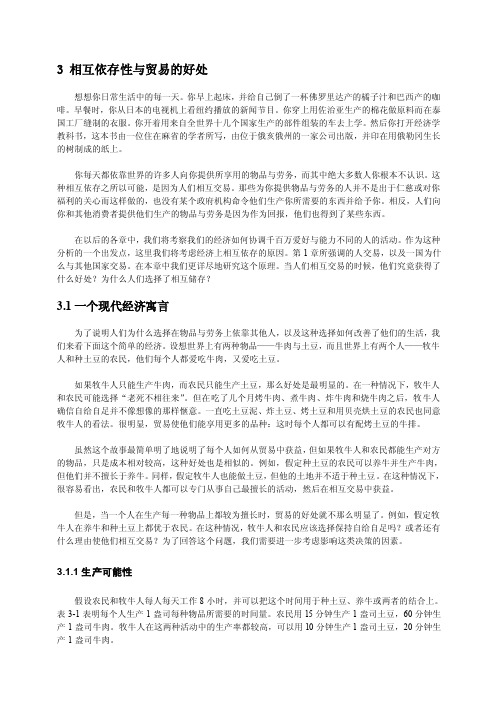
3 相互依存性与贸易的好处想想你日常生活中的每一天。
你早上起床,并给自己倒了一杯佛罗里达产的橘子汁和巴西产的咖啡。
早餐时,你从日本的电视机上看纽约播放的新闻节目。
你穿上用佐治亚生产的棉花做原料而在泰国工厂缝制的衣服。
你开着用来自全世界十几个国家生产的部件组装的车去上学。
然后你打开经济学教科书,这本书由一位住在麻省的学者所写,由位于俄亥俄州的一家公司出版,并印在用俄勒冈生长的树制成的纸上。
你每天都依靠世界的许多人向你提供所享用的物品与劳务,而其中绝大多数人你根本不认识。
这种相互依存之所以可能,是因为人们相互交易。
那些为你提供物品与劳务的人并不是出于仁慈或对你福利的关心而这样做的,也没有某个政府机构命令他们生产你所需要的东西并给予你。
相反,人们向你和其他消费者提供他们生产的物品与劳务是因为作为回报,他们也得到了某些东西。
在以后的各章中,我们将考察我们的经济如何协调千百万爱好与能力不同的人的活动。
作为这种分析的一个出发点,这里我们将考虑经济上相互依存的原因。
第1 章所强调的人交易,以及一国为什么与其他国家交易。
在本章中我们更详尽地研究这个原理。
当人们相互交易的时候,他们究竟获得了什么好处?为什么人们选择了相互储存?3.1一个现代经济寓言为了说明人们为什么选择在物品与劳务上依靠其他人,以及这种选择如何改善了他们的生活,我们来看下面这个简单的经济。
设想世界上有两种物品——牛肉与土豆,而且世界上有两个人——牧牛人和种土豆的农民,他们每个人都爱吃牛肉,又爱吃土豆。
如果牧牛人只能生产牛肉,而农民只能生产土豆,那么好处是最明显的。
在一种情况下,牧牛人和农民可能选择“老死不相往来”。
但在吃了几个月烤牛肉、煮牛肉、炸牛肉和烧牛肉之后,牧牛人确信自给自足并不像想像的那样惬意。
一直吃土豆泥、炸土豆、烤土豆和用贝壳烘土豆的农民也同意牧牛人的看法。
很明显,贸易使他们能享用更多的品种:这时每个人都可以有配烤土豆的牛排。
虽然这个故事最简单明了地说明了每个人如何从贸易中获益,但如果牧牛人和农民都能生产对方的物品,只是成本相对较高,这种好处也是相似的。
经济学原理 曼昆第三章
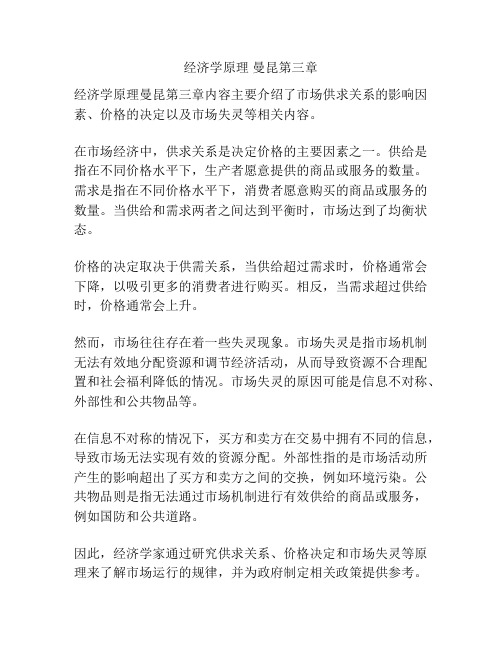
经济学原理曼昆第三章
经济学原理曼昆第三章内容主要介绍了市场供求关系的影响因素、价格的决定以及市场失灵等相关内容。
在市场经济中,供求关系是决定价格的主要因素之一。
供给是指在不同价格水平下,生产者愿意提供的商品或服务的数量。
需求是指在不同价格水平下,消费者愿意购买的商品或服务的数量。
当供给和需求两者之间达到平衡时,市场达到了均衡状态。
价格的决定取决于供需关系,当供给超过需求时,价格通常会下降,以吸引更多的消费者进行购买。
相反,当需求超过供给时,价格通常会上升。
然而,市场往往存在着一些失灵现象。
市场失灵是指市场机制无法有效地分配资源和调节经济活动,从而导致资源不合理配置和社会福利降低的情况。
市场失灵的原因可能是信息不对称、外部性和公共物品等。
在信息不对称的情况下,买方和卖方在交易中拥有不同的信息,导致市场无法实现有效的资源分配。
外部性指的是市场活动所产生的影响超出了买方和卖方之间的交换,例如环境污染。
公共物品则是指无法通过市场机制进行有效供给的商品或服务,例如国防和公共道路。
因此,经济学家通过研究供求关系、价格决定和市场失灵等原理来了解市场运行的规律,并为政府制定相关政策提供参考。
宏经第三章(曼昆)
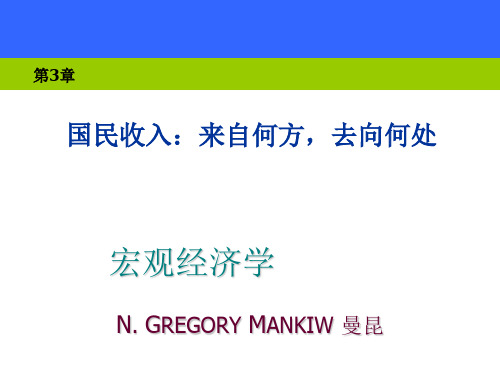
F (zK , zL) =
=
=
z K+ z L
z
(
K+ L
)
decreasing returns to scale for any z > 1
=
z F (K , L)
slide 7
例3
F (K , L) = K 2 + L2 F (zK , zL) = (zK )2 + (zL)2 = z 2 ( K 2 + L2 )
以MPL为纵轴, 为纵轴, L 为横轴
L 0 1 2 3 4 5 6 7 8 9 10
Y 0 10 19 27 34 40 45 49 52 54 55
MPL n.a. ? ? 8 ? ? ? ? ? ? ?
slide 19
Answers:
MPL (units of output)
Production function Output (Y)
G =G
and
T =T
slide 40
产品和劳务市场
总需求 总供给
C ( − T ) + I (r ) + G Y
Y = F (K , L )
Y = C ( − T ) + I (r ) + G Y
均衡
实际利率调整使需求等于供给
slide 41
可贷资金市场
金融系统中简单的供求模型 一种资产:可贷资金 资金需求:投资 investment 资金供给:储蓄 saving 资金价格: 实际利率 real interest rate
2 2
K2 = z L = z F (K , L)
constant returns to scale for any z > 0
曼昆《经济学原理(微观经济学分册)》(第6版)课后习题详解(第3章 相互依存性与贸易的好处)
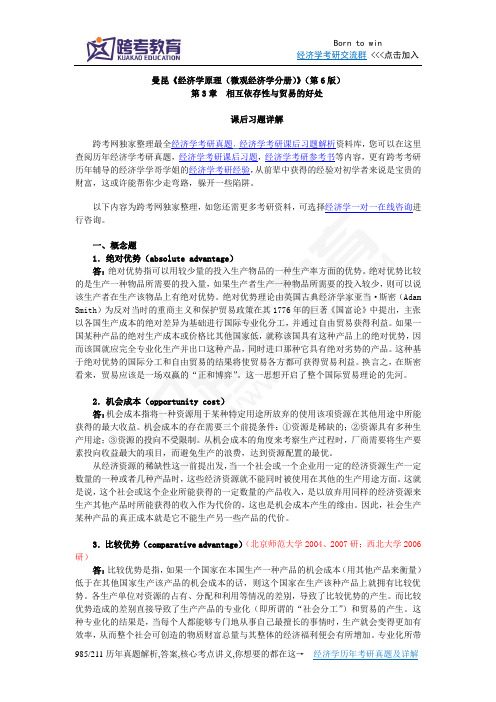
曼昆《经济学原理(微观经济学分册)》(第6版)第3章相互依存性与贸易的好处课后习题详解跨考网独家整理最全经济学考研真题,经济学考研课后习题解析资料库,您可以在这里查阅历年经济学考研真题,经济学考研课后习题,经济学考研参考书等内容,更有跨考考研历年辅导的经济学学哥学姐的经济学考研经验,从前辈中获得的经验对初学者来说是宝贵的财富,这或许能帮你少走弯路,躲开一些陷阱。
以下内容为跨考网独家整理,如您还需更多考研资料,可选择经济学一对一在线咨询进行咨询。
一、概念题1.绝对优势(absolute advantage)答:绝对优势指可以用较少量的投入生产物品的一种生产率方面的优势。
绝对优势比较的是生产一种物品所需要的投入量,如果生产者生产一种物品所需要的投入较少,则可以说该生产者在生产该物品上有绝对优势。
绝对优势理论由英国古典经济学家亚当·斯密(Adam Smith)为反对当时的重商主义和保护贸易政策在其1776年的巨著《国富论》中提出,主张以各国生产成本的绝对差异为基础进行国际专业化分工,并通过自由贸易获得利益。
如果一国某种产品的绝对生产成本或价格比其他国家低,就称该国具有这种产品上的绝对优势,因而该国就应完全专业化生产并出口这种产品,同时进口那种它具有绝对劣势的产品。
这种基于绝对优势的国际分工和自由贸易的结果将使贸易各方都可获得贸易利益。
换言之,在斯密看来,贸易应该是一场双赢的“正和博弈”。
这一思想开启了整个国际贸易理论的先河。
2.机会成本(opportunity cost)答:机会成本指将一种资源用于某种特定用途所放弃的使用该项资源在其他用途中所能获得的最大收益。
机会成本的存在需要三个前提条件:①资源是稀缺的;②资源具有多种生产用途;③资源的投向不受限制。
从机会成本的角度来考察生产过程时,厂商需要将生产要素投向收益最大的项目,而避免生产的浪费,达到资源配置的最优。
从经济资源的稀缺性这一前提出发,当一个社会或一个企业用一定的经济资源生产一定数量的一种或者几种产品时,这些经济资源就不能同时被使用在其他的生产用途方面。
曼昆《经济学原理》第6版 微观经济学分册 第3章 课后习题答案P63-P66

■复习题在什么情况下,生产可能性曲线是直线,而不是外凸的?【重要级别】☆☆☆【难度级别】☆☆☆【考查要点】生产可能性边界定义【参考答案】当生产一种产品的机会成本为常数时,生产可能性曲线是直线而不是外凸的。
解释绝对优势和比较优势有什么不同。
【重要级别】☆☆☆☆【难度级别】☆☆☆【考查要点】绝对优势定义;比较优势定义【参考答案】绝对优势和比较优势都是用于衡量不同生产者生产效率差异的概念,绝对优势以生产效率为评价标准,比较优势以机会成本为评价标准。
同一生产者可能同时在两种物品上都具有绝对优势,但不可能同时在两种物品上都拥有比较优势。
绝对优势反映了生产率的高低,比较优势反映了相对机会成本的高低。
举例说明一个人在做某件事上有绝对优势,而另一个人有比较优势。
【重要级别】☆☆☆【难度级别】☆☆【考查要点】绝对优势应用;比较优势应用【参考答案】工程师A每小时的工资为500元,一个小时可以把自己的家打扫干净。
B每小时的工资为50元,两个小时可以把与A相同面积的房屋打扫干净。
在此例中,无论是赚钱还是打扫房间,A都拥有绝对优势。
但从比较优势的角度来看,打扫A的家,A的机会成本是500元,而B的机会成本是100元,所以B在打扫房间上具有比较优势。
对贸易来说,是绝对优势重要还是比较优势重要?以你对上一道题的答案为例来解释你的推理。
【重要级别】☆☆☆☆【难度级别】☆☆【考查要点】绝对优势应用;比较优势应用【参考答案】对贸易而言,比较优势重要。
如果按照绝对优势,A和B之间没有从事贸易的可能。
但是如果从比较优势来看,A专门工作而B专门打扫房间,在相同的时间内,A和B都可以获得更高的收入,这样双方的状况都变得更好。
一国是倾向于出口还是进口自己有比较优势的物品?解释原因。
【重要级别】☆☆☆☆【难度级别】☆☆【考查要点】比较优势应用【参考答案】倾向于出口自己具有比较优势的产品。
因为在该国的生产效率和资源禀赋不变的条件下,出口自己具有比较优势的产品并进口自己没有比较优势的产品可以获得更多的消费者组合。
【曼昆 宏观经济学 经典】Mankiw 5e Chapter 3

1Mankiw 5e Chapter 3The returns to scale in the production function Y = K 0.5 L 0.5 areA. decreasing.B. constant.C. increasing.D. subject to wide fluctuations.1 out of 1Correct. The answer is B. If the amounts of capital and labor were both doubled, then output would double. This implies that the above production function has constant returns to scale. See Section 3-1.If a production function has two inputs and exhibits constant returns to scale, then doubling both inputs will cause the output toA. reduce by half.B. stay the same.C. double.D. quadruple.1 out of 12Correct. The answer is C. If a production function has constant returns to scale, then an equal percentage increase in all factors of production causes the same percentage increase in output. See Section 3-1.If the supplies of capital and labor are fixed and technology is unchanging, then real output isA. fixed.B. determined by demand.C. uncertain.D. subject to wide fluctuations.1 out of 1Correct. The answer is A. In this case, real output will be fixed. As discussed in Section 3-1, it can only change if capital, labor, or technology change.If a production function has the property of diminishing marginal product, then doublingA. all of the inputs will less than double the output.B. all of the inputs will double the output.C. all of the inputs will more than double the output.D. one of the inputs will reduce its marginal product.31 out of 1Correct. The answer is D.If a production function has the property of diminishing marginal product, then increasing the amount of one input reduces its marginal product. See Section 3-2.Consider the following production table:Labor Capital Output(i) 1,000 1,000 10,000 (ii) 2,002 2,000 20,010Assuming that the production function displays constant returns to scale, what is the marginal product of labor when labor and capital are both equal to 1,000?A. 1B. 5C. 10D. 201 out of 1Correct. The answer is B. Since the above production function has constant returns to scale, row (ii) may be divided by 2 to yield the following information: 1,001 units of labor and 1,000 unit of capital produce 10,005 units of output. Hence, the marginal product of labor when capital and labor are both equal to 1,000 is 5. See Section 3-2.4Consider the following production table: Labor Capital Output 1 2 3 2 2 6 3 28By how much does the marginal product of labor decrease as labor input increases from 1 to 2 and from 2 to 3?A. 0B. 1C. 2D. 31 out of 1Correct. The answer is B. When labor input increases from 1 to 2 the change in output is 3. Thus means the marginal product of labor is equal to 3. Likewise, the marginal product when labor input increases from 2 to 3 is equal to 2. Thus, the change in the marginal product of labor is 1. See Section 3-2.Euler's theorem implies that if a production function exhibits constant returns to5scaleA. economic profit is zero.B. accounting profit is zero.C. the marginal product of labor equals the real wage.D. the marginal product of capital equals the real interest rate.1 out of 1Correct. The answer is A. Euler's theorem states that if each factor is paid its marginal product, then the sum of these factor payments equals output. This implies that economic profit is zero. See Section 3-2 for a more detailed explanation of Euler's theorem.If a firm with a constant returns to scale production function pays all factors their marginal products, thenA. economic and accounting profits are both zero.B. economic profit is zero and accounting profit is positive.C. economic profit is positive and accounting profit is zero.D. economic and accounting profit are both positive.1 out of 1Correct. The answer is B. Euler's theorem guarantees that economic profits are zero. Accounting profits equal economic profits plus the return to capital. Since the6return to capital is positive, accounting profits must be positive. See Section 3-2.Which of the following is not a decision made by a competitive firm?A. The number of employees to hireB. How much to invest in machinesC. What price to ask for its productD. How much to produce1 out of 1Correct. The answer is C. A competitive firm is assumed to take the price as given. See Section 3-2.A competitive firm hires labor until the marginal product of labor equals theA. real wage.B. rental price of capital.C. price of output.D. capital/labor ratio.1 out of 1Correct. The answer is A. In order to maximize profit, a firm will hire labor as long as the extra revenue from an additional unit (the marginal product) is greater than7or equal to the cost (the wage). Thus, the firm hires labor until the marginal product of labor equals the wage. See Section 3-2.A competitive firm rents capital until the marginal product of capital equals theA. real wage.B. rental price of capital.C. price of output.D. capital/labor ratio.1 out of 1Correct. The answer is B. In order to maximize profit, a firm will rent capital as long as the extra revenue from an additional unit (the marginal product) is greater than or equal to the cost (the rental price).Thus, the firm hires capital until the marginal product of capital equals the rental price. See Section 3-2.Economic profit is the same as accounting profit minusA. the return to labor.B. the return to capital.C. depreciation.D. corporate taxes.0 out of 1Incorrect. The correct answer is B. As explained in Section 3-2, accounting profits include both economic profits and the return to capital.Suppose that a major natural disaster destroys a large part of a country's capital stock but miraculously does not cause anybody bodily harm. What will happen to the real wage rate?A. It will not change.B. It will rise.C. It will fall.D. It could rise or fall.1 out of 1Correct. The answer is C. As explained in Section 3-2, the real wage paid to each worker equals the marginal product of labor. If a large part of the capital stock is destroyed, then there will be less capital per worker, which means the marginal product of labor will be lower. This will result in a lower real wage.Which of the following is not a characteristic of the Cobb-Douglas production function?A. Capital and labor receive equal fractions of income.89B. Economic profit is zero.C. Factor payments are a constant fraction of income.D. Constant returns to scale.1 out of 1Correct. The answer is A. For an explanation of the properties of the Cobb-Douglas production function, see Appendix to Chapter 3.In the Cobb-Douglas production function, Y = K a L 1-a , the fraction of income spent in payments to labor isA. a.B. 1 - a.C. dependent on the amount of labor employed.D. dependent on the amount of capital employed.1 out of 1Correct. The answer is B. Since the real wage equals the marginal product of labor (MPL), payments to labor (L) equal MPL * L. As shown in the Appendix to Chapter 3, the MPL of the above production function equals (1 - a)Y/L. Therefore payments to labor equal (1 - a)Y and (1 - a) is the fraction of income spent in payments to labor.10In a closed economy, the supply of goods and services must be equal toA. consumption.B. consumption + investment.C. consumption + investment + government purchases.D. consumption + investment + government purchases - taxes.1 out of 1Correct. The answer is C. As explained in Section 3-3, in a closed economy, the supply of goods and services is allocated among three uses--consumption, investment, and government purchases.Suppose that a consumer has a marginal propensity to consume of 0.7. If this consumer earns an extra $2, her consumption spending would be expected to increase byA. $0.60.B. $0.70.C. $1.40.D. $1.70.1 out of 1Correct. The answer is C. Since her marginal propensity to consume is 0.7, this11individual will consume 70 cents of every dollar she earns. Therefore, if her income rises by $2, her consumption spending will rise by $1.40. See Section 3-3.Suppose that a consumer has a marginal propensity to consume of 0.8. If this consumer receives and extra $2 of disposable income, her saving would be expected to increase byA. $0.40.B. $0.80.C. $1.20.D. $1.60.1 out of 1Correct. The answer is A. Since her marginal propensity to consume is 0.8, this individual will consume 80 cents of every dollar she earns. Therefore, if her disposable income increases by $2, she will consume and extra $1.60, and save an extra 40 cents. See Section 3-3.Which of the following operations is not considered investment?A. A family builds a house in which it plans to live.B. A car dealer stores some of this year's models for next year.C. An individual purchases several pieces of antique furniture.12D. A firm buys a computer for word processing.0 out of 1Incorrect. The correct answer is C. As discussed in Section 3-3, the reallocation of existing assets among different individuals is not investment for economy.Suppose that Jones builds a new house, then she sells it to Smith, and then Smith sells it to Williams. The total net investment from these transactions isA. zero.B. 1 house.C. 2 houses.D. 3 houses.1 out of 1Correct. The answer is B. As explained in Section 3-3, building a new house counts as investment; selling an existing house does not.If the real interest rate rises, the quantity of investment demandedA. will fall.B. will not change.C. will rise.13D. could rise or fall.1 out of 1Correct. The answer is A. To be profitable, the return on an investment must exceed its cost. The real interest rate represents the cost of investment. Thus, if the real interest rate rises, fewer investment projects are profitable, so the quantity of investment demanded will fall. See Section 3-3.The real interest rate is equal to the nominal interest rate minusA. accounting profit.B. economic profit.C. taxes.D. inflation.1 out of 1Correct. The answer is C. As explained in Section 3-3, the real interest rate is equal to the nominal interest rate minus inflation.Choose the pair of words that best completes this sentence: Investment depends on the ________ interest rate because higher inflation will ________ the value of the dollars with which the firm will repay the loan.14A. real, increaseB. nominal, increaseC. real, decreaseD. nominal, decrease0 out of 1Incorrect. The correct answer is C. As explained in Section 3-3, the nominal interest rate is the rate that investors pay to borrow money, but it is the real interest rate that firms care about when they make their investment decisions because higher inflation decreases the value of the dollars with which the firm will repay the loan.In a closed economy that is in equilibrium, investment is equal toA. private saving.B. public saving.C. private saving plus public saving.D. disposable income minus consumption.1 out of 1Correct. The answer is C. In equilibrium, the supply of loanable funds must equal the demand. In a closed economy, the demand for loanable funds is investment and the supply is the sum of private and public saving. Thus, investment must equal private saving plus public saving. See Section 3-4.15The government is running a budget deficit ifA. government spending is greater than tax revenue.B. tax revenue is greater than government spending.C. tax revenue is greater than consumption spending.D. tax revenue is greater than investment spending.1 out of 1Correct. The answer is A. If the government spends more than the revenue it receives from taxes, then it runs a budget deficit. See Section 3-3.Private saving is equal toA. income - consumption.B. income - consumption - taxes.C. income - consumption - government spending.D. income - consumption - government spending - taxes.1 out of 1Correct. The answer is B. Private saving equals income minus consumption and taxes. See section 3-4.16The supply of loanable funds, or "national saving," is equal toA. income - consumption.B. income - consumption - taxes.C. income - consumption - government spending.D. income - consumption - government spending - taxes.1 out of 1Correct. The answer is C. National saving is equal to the sum of private and public saving. Since private saving is equal to income minus consumption and taxes and public savings is equal to taxes minus government spending, national saving equals income minus consumption and government spending. See Section 3-4.In a closed economy, with total output and taxes fixed, if government spending risesA. consumption falls.B. national saving rises.C. the real interest rate falls.D. investment falls.1 out of 1Correct. The answer is D. If government spending rises, then public saving falls.17This means that national saving--the supply of loanable funds--falls. Thus the real interest rate must rise so that the demand for loanable funds--investment--falls. See Section 3-4.In a closed economy with total income fixed, a reduction in taxes will cause consumptionA. to rise and investment to fall.B. and investment both to rise.C. to fall and investment to rise.D. and investment both to fall.0 out of 1Incorrect. The correct answer is A. Lower taxes imply higher disposable income. This means that consumption will rise. This also means that national saving (income minus consumption and government spending) will fall. Since investment must equal national saving in a closed economy, investment must also fall. See Section 3-4.Suppose that there is a positive shock to investment demand: that is, at every interest rate, the desired amount of investment rises. In a closed economy with the national saving fixed, the real interest rate will18A. fall.B. remain constant.C. rise.D. first fall and then rise.1 out of 1Correct. The answer is C. An increase in investment demand represents an increase in the demand for loanable funds. Since the supply of loanable funds (national saving) is fixed, the real interest rate must rise so that the quantity of investment demanded will fall and the market for loanable funds will remain in equilibrium. See Section 3-4.According to the simple macroeconomic model presented in Chapter 3, which of the following will not be caused by an increase in government spending?A. Increase in interest rateB. Decrease in consumptionC. Decrease in investmentD. Increase in government debt1 out of 1Correct. The answer is B. Consumption depends only on disposable income (income minus taxes). See Section 3-4.19In a closed economy with output fixed, an increase in government spending matched by an equal increase in taxes willA. increase consumption.B. increase the interest rate.C. increase investment.D. leave all other variables unchanged.1 out of 1Correct. The answer is B. National saving (the supply of loanable funds) decreases since the reduction in consumption caused by the tax increase is not large enough to offset the increase in government spending. This means that the interest rate must rise so that investment (the demand for loanable funds) will also fall. See Section 3-4.In a closed economy with fixed output, an increase in government spending without any change in taxes will lead to a(n)A. increase in the real interest rate and a decrease inprivate saving.B. decrease in the real interest rate and an increase in private saving.20C. decrease in the real interest rate and no change in privatesaving.D. increase in the real interest rate and no change in private saving.1 out of 1Correct. The answer is D. Since output and taxes do not change, private saving does not change. National saving falls due to the increase in government spending. Since saving must equal investment, the fall in national saving causes the interest rate to rise so that the quantity of investment demanded also falls. See Section 3-4.In the simple macroeconomic model of Chapter 3, a decrease in taxes will shift theA. investment demand curve to the left.B. investment demand curve to the right.C. savings curve to the left.D. savings curve to the right.0 out of 1Incorrect. The correct answer is C. A decrease in taxes causes consumption to rise. This means that national saving falls. See Section 3-4.旗开得胜读万卷书 行万里路 21A leftward shift of the savings curve cannot be caused by a(n)A. positive shock to consumption.B. increase in the government budget deficit.C. reduction in taxes.D. increase in the real interest rate.0 out of 1Incorrect. The correct answer is D. A leftward shift in the savings curve will cause an increase in the interest rate but cannot be caused by such an increase. See Section 3-4.In the full model of the economy presented in chapter 3, the variable that adjusts to equilibrate the supply and demand for goods and services isA. government spending.B. consumption.C. taxes.D. the real interest rate.1 out of 1Correct. The answer is D. See Section 3-4 for an explanation of the model.。
曼昆《经济学原理》Chapter 03

1
A Parable for the Modern Economy
• Only two goods
– Meat – Potatoes
• Only two people
– Rancher – Farmer
© 2011 Cengage Learning. All Rights Reserved. May not be copied, scanned, or duplicated, in whole or in part, except for use as permitted in a license distributed with a certain product or service or otherwise oБайду номын сангаас a password-protected website for classroom use.
7
Figure 2
How Trade Expands the Set of Consumption Opportunities (a, b)
(a) The farmer’s production and consumption Meat (oz)
- 1、下载文档前请自行甄别文档内容的完整性,平台不提供额外的编辑、内容补充、找答案等附加服务。
- 2、"仅部分预览"的文档,不可在线预览部分如存在完整性等问题,可反馈申请退款(可完整预览的文档不适用该条件!)。
- 3、如文档侵犯您的权益,请联系客服反馈,我们会尽快为您处理(人工客服工作时间:9:00-18:30)。
© 2012 Cengage Learning. All Rights Reserved. May not be copied, scanned, or duplicated, in whole or in part, except for use as permitted in a license distributed with a certain product or service or otherwise on a password-protected website for classroom use.
2
A Parable for the Modern Economy
• A simple model (gains from trade)
– Principle 5: Trade can make everyone better off
• Assume only two goods
– Meat – Potatoes
8
Figure 2
How Trade Expands the Set of Consumption Opportunities (a, b)
(a) The farmer’s production and consumption Meat (oz)
Farmer's production and consumption without trade
© 2012 Cengage Learning. All Rights Reserved. May not be copied, scanned, or duplicated, in whole or in part, except for use as permitted in a license distributed with a certain product or service or otherwise on a password-protected website for classroom use.
• As given in the next slide
• Assume constant rate of transformation (potato and
meat can be switched at a constant rate)- PPF is a straight line
© 2012 Cengage Learning. All Rights Reserved. May not be copied, scanned, or duplicated, in whole or in part, except for use as permitted in a license distributed with a certain product or service or otherwise on a password-protected website for classroom use.
4
A Parable for the Modern Economy
• Want to show “both could gain by trade,” even in the situation 2 • Production possibilities frontier
– “Mixes of outputs that can be produced efficiently” – Assume the available resource (time) and production capability (productivity) are given
7
A Parable for the Modern Economy
• Specialization and trade
– Initial condition A & B in previous slide – Farmer – specialize in growing potatoes
• Devote all time growing potatoes
32 Potatoes (oz)
0
24
48 Potatoes (oz)
Panel (b) shows the combinations of meat and potatoes that the farmer can produce. Panel (c) shows the combinations of meat and potatoes that the rancher can produce. Both production possibilities frontiers are derived assuming that the farmer and rancher each work 8 hours per day. If there is no trade, each person’s production possibilities frontier is also his or her consumption possibilities frontier.
• Assume only two people
– Rancher – Farmer – Both want to consume both meat and potato
© 2012 Cengage Learning. All Rights Reserved. May not be copied, scanned, or duplicated, in whole or in part, except for use as permitted in a license distributed with a certain product or service or otherwise on a password-protected website for classroom use.
1
Interdependence
• Consider our daily life
– Eat food, wear cloths, move around, etc. – We depend on many other people, which become possible due to trade across people (countries)
3
A Parable for the Modern Economy
• Situation 1
– Rancher produces only meat & farmer produces only potatoes
• Consume only what they produce
– Both could gain from trade
6
Figure 1
The Production Possibilities Frontier (b, c)
(b) The farmer’s production possibilities frontier Meat (oz)
If there is no trade, the farmer chooses this production and consumption.
(c) The rancher’s production possibilities frontier Meat (oz) 24
If there is no trade, the rancher chooses this production and consumption.
8 12 4 A
B
0
16
(b) The rancher’s production and consumption Meat (oz)
– Rancher – specialize in raising cattle
• Reduce time for growing potato into half, using
the time to produce meat (next slide)
– Trade: 5 oz of meat for 15 oz of potatoes – Both gain from specialization and trade
• Both can consume more of both goods
© 2012 Cengage Learning. All Rights Reserved. May not be copied, scanned, or duplicated, in whole or in part, except for use as permitted in a license distributed with a certain product or service or otherwise on a password-protected website for classroom use.
• People provide you with goods and services
they produce, because they get something in return
© 2012 Cengage Learning. All Rights Reserved. May not be copied, scanned, or duplicated, in whole or in part, except for use as permitted in a license distributed with a certain product or service or otherwise on a password-protected website for classroom use.
